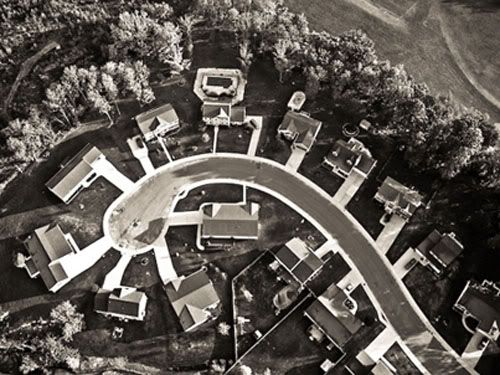From ages 10-18 I lived at the bottom of a cul-de-sac. It is a fairly common feature of the suburban landscape. Who thought of it? Why not just have streets at 90 degree cross angles, like a grid? Why these weird little off-shoots, these appendages?
In his article “Cul-de-Sacs: Suburban Dream or Dead End?” John Nielsen writes, “Developers learned that cul-de-sacs allowed them to fit more houses into oddly shaped tracts, and to build right up to the edges of rivers and property lines.” The primary function of cul-de-sacs was to maximize profits for developers. But what impact do they have on residents?
According to the London Times, “the sprawling and looping design of cul-de-sacs forces people into their cars...many people routinely burn a litre of petrol on a shopping trip for a pint of milk.” Cul-de-sacs are not environmentally friendly, as opposed to the more urban grid design, which allows people to walk to shops instead of driving their cars.
But the impact goes deeper, I think, than money or cars. Living in a cul-de-sac sort of isolated my family, so that the only neighbors we really knew or talked to were among those four houses who shared our cul-de-sac.
There was the S______ family next door. They had two boys around the same age as my brother and me. I envied them because they were allowed to listen to heavy metal and eat junk food and they had a pool.
Then there was the D______ family. Mr. D was a police detective. I don’t know if Mrs. D worked. Their son, who was in his 30s, still lived with them because he had been in a motorcycle accident and had a metal plate in his head and brain damage. He was, I supposed, unable to live on his own. He was, however, very good at volleyball and he could ride a skateboard on his hands, which I thought was pretty awesome.
The two families who lived in the other two houses were kind of mysterious to me. We didn’t talk to them much for some reason.
There was an older couple who lived at the top of our cul-de-sac. My parents would talk to them sometimes. I wasn’t too interested in them because they didn’t play roller hockey or video games. The older woman was Scandinavian and her name sounded like “Yoda.” I’m sure it was spelled differently than the Jedi master, but I always told my friends, “Yoda lives in that house.”
Now that I live downtown in an apartment, I find the world of the cul-de-sac kind of strange. It was so quiet compared to the hustle and bustle of where I live now, where the streets are gridded and I can walk or bike almost everywhere I need to go, and where I run into friends and acquaintances all the time, just walking down my street. In previous generations, it was kind of assumed that when you get married, and especially when you have kids, that you get a house in a suburb. The “American Dream” used to consist of a house, a job, and a family. I think it is safe to say that my generation has a different definition of the “American Dream.” I suppose, like every generation, mine has defined itself partially in opposition to its predecessor, and partially in light of new developments, new technology, and new ways of thinking.

